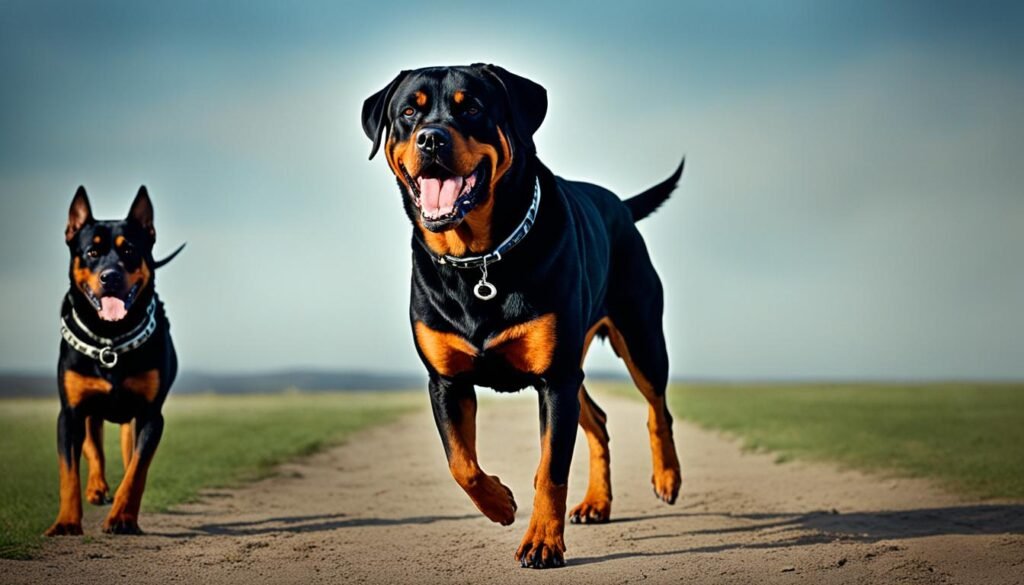Did you know that wolves possess an impressive repertoire of fifteen main behaviors for negotiating conflicts over resources, with nine dominance behaviors and six submission behaviors1? However, the same cannot be said for all dog breeds, as the Siberian Husky breed possesses all fifteen negotiation skills, while the Cavalier King Charles Spaniel breed only has two1. These stark differences in social skills suggest that certain dog breeds may be predisposed to more aggressive tendencies, challenging the notion of a single “king of aggression” among canines.
Aggression in the natural world is often a strategic response based on a cost-benefit analysis, considering factors like resource scarcity and potential harm1. Surprisingly, actual aggression in dogs, defined as the intent to cause physical harm or death, is quite rare, with most perceived aggressive behaviors rooted in fear and intended to create space rather than inflict damage1. Understanding the nuances of canine aggression is crucial for helping dogs overcome their fears and cultivate more appropriate social behaviors.
Key Takeaways
- Dog breeds possess varying levels of negotiation skills for resolving conflicts, with some breeds like the Siberian Husky having a more comprehensive repertoire.
- Aggression in the natural world is a strategic response, but actual aggressive behavior in dogs is often driven by fear rather than an intent to cause harm.
- Recognizing the root causes of aggressive behaviors in dogs is essential for effective training and behavior modification.
- Dominance-based training techniques have been criticized by experts, highlighting the need for a more nuanced understanding of canine social dynamics.
- Factors such as breed, sex, and underlying medical conditions can influence the likelihood and expression of aggressive behaviors in dogs.
Debunking Myths: Breed-Specific Aggression
Breed-specific legislation (BSL) is often based on the assumption that certain dog breeds are inherently more aggressive than others. However, research has challenged this notion, highlighting the significant variation in behavioral traits within dog breeds compared to the variation between breeds2.
Heritability of Aggressive Behavior in Dogs
A recent genomic study revealed that while most canine behavioral traits have relatively high heritability, breed explains only 9% of the behavioral variation among individual dogs2. This suggests that the tendency towards aggression is not as strongly linked to a dog’s breed as commonly believed.
Studies comparing the behavioral responses of dogs from legislated and non-legislated breeds have found no significant differences, indicating that breed alone is not a reliable predictor of individual behavioral tendencies, including aggression3. In fact, the American Veterinary Medical Association (AVMA) has stated that breed is a poor predictor of aggressive behavior in dogs3.
The American Temperament Test Society (ATTS) reports that Pit Bull-type dogs consistently achieve a high pass rate in temperament tests, comparable to or better than breeds like the Golden Retriever3. This further challenges the notion that certain breeds, such as pit bulls, are inherently more aggressive.
Overall, the research suggests that the tendency towards aggression in dogs is not primarily determined by breed, but rather by a complex interplay of genetic, environmental, and individual factors. Relying on breed-specific legislation to address canine aggression may be an oversimplified and ineffective approach.
“Breed alone is a poor predictor of aggressive behavior in dogs.”3 – American Veterinary Medical Association
Which dog is king of aggression?

When it comes to dog aggression, there are common misconceptions that certain breeds are inherently more aggressive than others. However, research suggests that breed alone is not a reliable predictor of a dog’s temperament or likelihood of displaying aggressive behaviors4. The distinction between dominance and aggression is crucial – dominance is about controlling resources, while aggression is about inflicting harm.
While some breeds, such as Rough Collies, Toy and Miniature Poodles, and Miniature Schnauzers, have been identified as more aggressive in studies4, it’s important to recognize that a dog’s individual personality and environment play a significant role in shaping its behavior. Factors like genetics, socialization, and training all contribute to a dog’s temperament and its likelihood of exhibiting aggressive tendencies.
Interestingly, smaller dogs, such as Toy, Miniature, and Medium Poodles, have been observed to display more aggressive behaviors like growling, snapping, and barking compared to mid-sized and larger dogs4. Additionally, male dogs have been found to be more aggressive than their female counterparts4. However, it’s important to note that a dog’s personality can also influence its aggression levels, regardless of breed or gender.
When it comes to managing dominant behaviors in dogs, proper training and socialization are key. Owners should focus on positive reinforcement and providing their canine companions with the appropriate outlets for their energy and natural instincts. By addressing the underlying causes of aggression, rather than relying solely on breed restrictions, we can create a safer and more harmonious environment for both humans and their furry friends.
| Aggressive Dog Breeds | Less Aggressive Dog Breeds |
|---|---|
| American Bulldogs5 | Golden Retrievers5 |
| Pit Bull Terriers5 | Labrador Retrievers45 |
| Staffordshire Terriers5 | Scenthounds5 |
| Rough Collies4 | Dogs that spend time with other canines4 |
| Toy, Miniature, and Medium Poodles4 | – |
| Miniature Schnauzers4 | – |
The data showcases clear differences in aggression levels among various dog breeds5. While certain breeds, such as American Bulldogs, Pit Bull Terriers, and Staffordshire Terriers, have been identified as the most aggressive5, breeds like Golden Retrievers, Labrador Retrievers, and Scenthounds are considered among the least aggressive5. Interestingly, smaller breeds like Toy, Miniature, and Medium Poodles have also been observed to exhibit more aggressive behaviors4.
Ultimately, it’s crucial to remember that a dog’s temperament is influenced by a variety of factors, and breed alone should not be the sole determinant of a dog’s potential for aggression. By understanding the nuances of dominance and aggression, and focusing on proper training and socialization, owners can effectively manage their canine companions’ behaviors and create a safer, more harmonious environment for all.
Conclusion
The perception that certain dog breeds are more likely to exhibit aggressive behavior has led to the introduction of breed-specific legislation, but research suggests this approach is not well-supported6. While aggressive behavior in dogs is a significant public health concern, breed alone is not a reliable predictor of individual tendencies6. Factors like genetics, environment, and training all contribute to a dog’s behavior, and the distinction between dominance and aggression is important7. Proper management of dominant behaviors, rather than breed restrictions, may be a more effective approach to reducing the risk of dangerous dog incidents6.
Understanding the nuances of canine aggression and temperament is crucial for developing effective strategies to address this complex issue8. The CDC estimates roughly 4.5 million individuals are bitten by dogs annually in the US, leading to an average of 43 fatalities per year, and certain breeds have been associated with a higher risk of attacks due to factors like predatory instincts, selective breeding, and genetic factors8. However, breed-specific legislation has not been shown to effectively predict or prevent individual behavioral tendencies related to aggression, as there is high variation within breeds in traits like aggression compared to variation between breeds6.
Moving forward, a more comprehensive approach that considers the multifaceted nature of canine behavior, rather than relying solely on breed, is essential for addressing the issue of aggressive dog incidents and promoting public safety6. By understanding the complex interplay of factors that contribute to a dog’s temperament and behavior, and implementing evidence-based strategies for managing dominant behaviors, we can work towards creating a safer environment for both humans and canines.
FAQ
What are the key factors that influence a dog’s aggressive behavior?
Factors like genetics, environment, and training all play a role in shaping a dog’s behavior, including aggression. While certain dog breeds have been historically associated with aggressive tendencies, research suggests that breed alone is not a reliable predictor of individual behavioral traits.
Is breed-specific legislation an effective approach to addressing aggressive dog behavior?
No, research has shown that breed-specific legislation is not an effective approach to reducing aggressive dog behavior. Studies have found that there is relatively high variation in behavioral traits, including aggression, within breeds compared to variation between breeds. Focusing on individual temperament and proper management of dominant behaviors may be a more effective strategy.
What is the difference between dominance and aggression in dogs?
Dominance is about controlling resources, while aggression is about inflicting harm. Naturally dominant dogs are not necessarily aggressive, but their behaviors can become problematic if not properly managed by owners. Proper training and socialization can help mitigate issues related to dominance without resorting to aggression.
Which dog breeds are commonly considered more aggressive?
Certain dog breeds, predominantly those historically used for guarding work or dog fighting, are commonly considered more likely to exhibit problematic aggressive behavior. However, research suggests that breed alone is not a reliable predictor of individual behavioral tendencies, including aggression.
How can owners effectively manage aggressive behavior in dogs?
Focusing on individual temperament and proper management of dominant behaviors, rather than breed restrictions, may be a more effective approach to reducing the risk of dangerous dog incidents. Proper training, socialization, and responsible ownership are key to managing aggressive tendencies in dogs.







